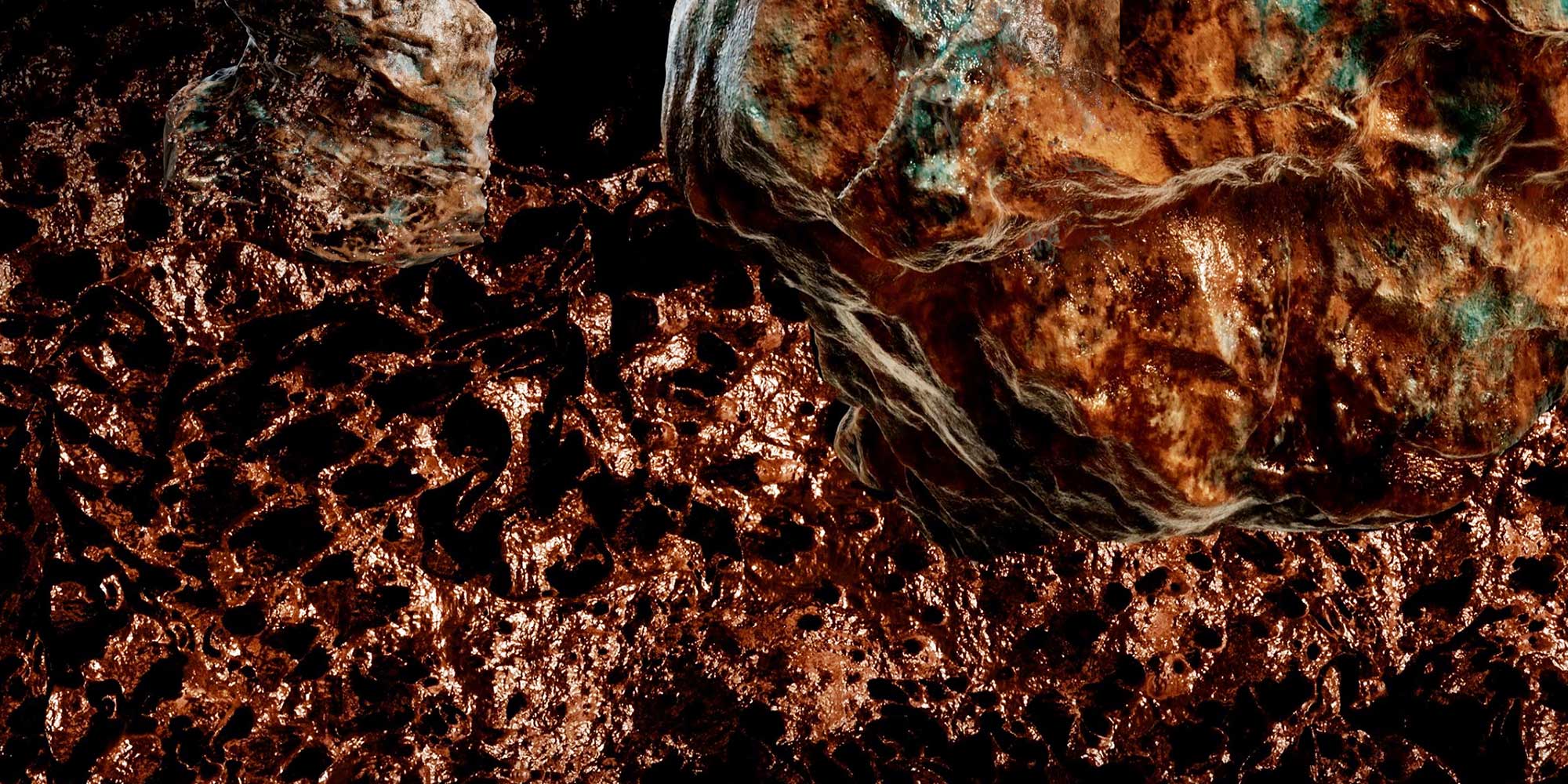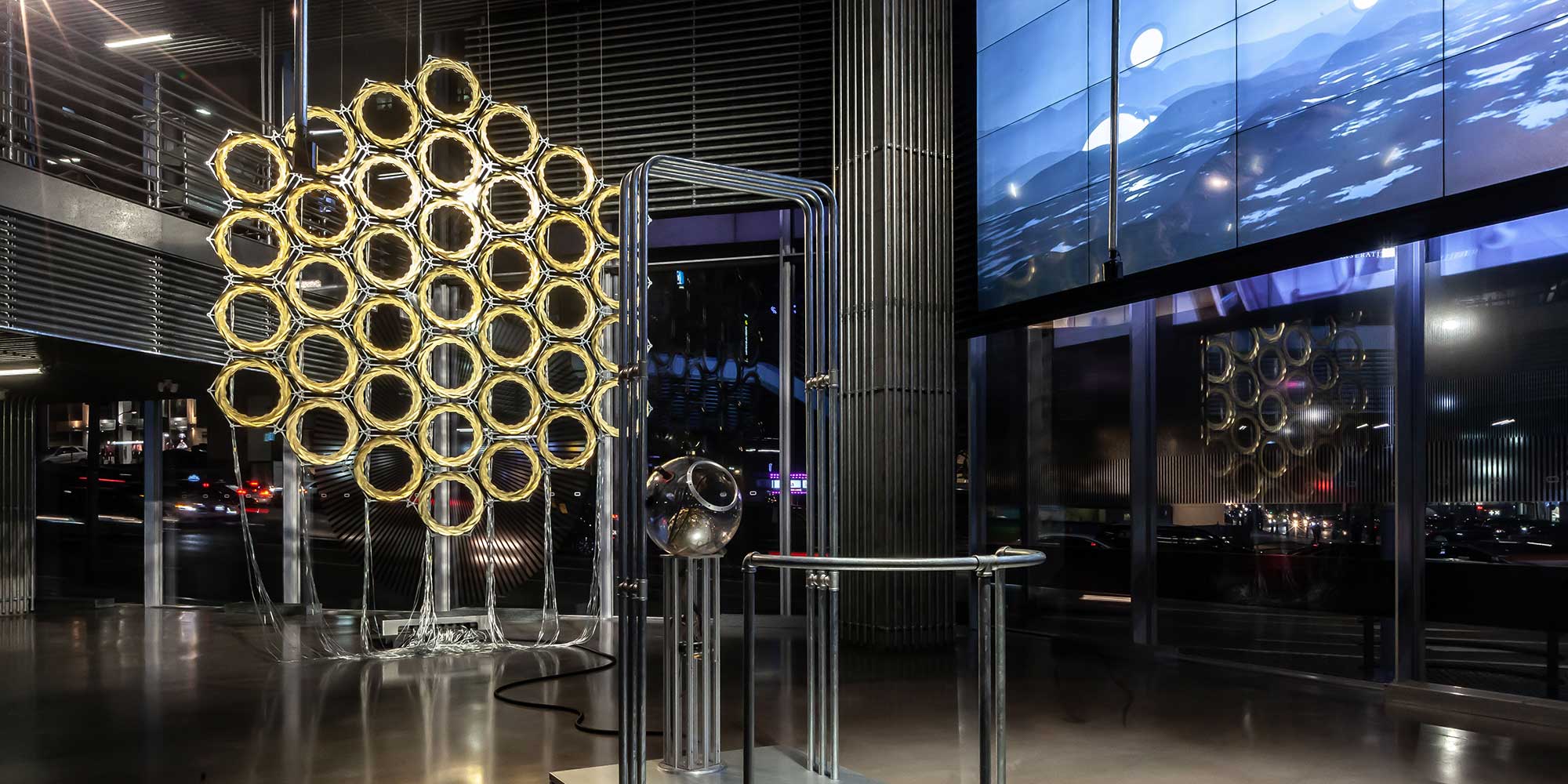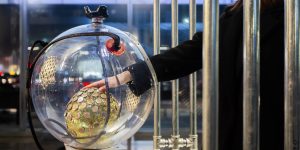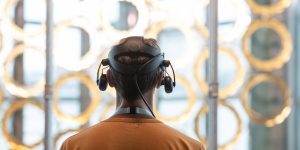Hyundai Motor Company is one of the most committed supporters of contemporary arts and culture globally with various approaches – decade-long partnerships with the National Museum of Modern and Contemporary Art, Korea (MMCA), Tate, the Los Angeles County Museum of Art (LACMA), and partnerships with major art world events including the Biennale of Sydney, Korean Pavilion at the Venice Biennale and collaboration with the global media group Bloomberg, as well as supporting numerous art initiatives and prizes around the globe. With a worldwide network of partnerships, Hyundai believes art is a lens that helps them expand their understanding of the world and move forward with the right questions for society. With their belief, Hyundai moves between the poles of art, technology and society, knowing that the cooperation with arts and culture stimulates critical and innovative thinking.
Through working with Ars Electronica, Hyundai shares and improves their perspective on society as a place for collaboration and innovation together. In 2018/19, Hyundai and Ars Electronica have jointly curated three exhibitions on the theme of “Future Humanity — Our Shared Planet,” which were shown at the Hyundai Motorstudios in Beijing, Seoul and Moscow. Furthermore, the two partners have successfully collaborated on several projects, all with one common goal: to explore the intersection of art, technology and society.
The next big project will be shown as the exhibition Human (un)limited, taking place once again at the Hyundai Motorstudios in Beijing, Seoul and Moscow from 19 November 2019 until 29 February 2020. It links up thematically with this year’s Festival theme exhibition.
VH Award in Seoul

Hyundai supports and cultivates young, talented media artists in Korea and helps them to gain international recognition, e. g. through the enormous Vision Hall screen, a unique media platform located in Hyundai Motor Group University Mabuk Campus. It won recognition from three top international design awards – IDEA, Red Dot and iF; Hyundai reaches the audience with a fresh genre of new media art as a way of communication to settle as a closer field of art. Drawing on longstanding experience with the Prix Ars Electronica, Ars Electronica contributed to the establishment of the Award, with the festival’s senior director Martin Honzik being one of the judges from the very beginning. The three works presented here are the three Grand Prix Winners of the VH Awards.
Additionally, the three winning works of the 3rd VH Award, A Thousand Horizons (by Dongjoo Seo, Grand Prix), Highway like a Shooting Star (by Youngkak Cho, finalist) and BLACK AIR (by Chansook Choi, finalist) will be shown in Ars Electronica’s Deep Space 8k during the festival on Thursday, 5 September, 19:30 – 20:00 & Monday 9 September, 17:00 – 17:30.
Dongjoo Seo (KR)
A Thousand Horizons
A Thousand Horizons combines CG and the repetitive page-turning of a book, captured through an unfamiliar perspective. Through the constantly expanding and changing horizontal landscape of the symbolic time of ”day,” it explores the digital and analog media’s temporal, spatial, and material properties, metaphorizing human reason, action, and interaction. It poses questions about the being between macro — micro, external — internal, conceptual — abstract, real — fantasy, nature — artificial, body — mind, captivating visitors into a synesthetic experience.
Hyungkyu Kim (KR)
Hear the Wind_Across the Border
This “360 degree view through media” extends the viewer’s role from passive recipient to neutral onlooker or even to an active observer. Viewers confront a 360-degree view of landscapes seen from Imjingak; Yeonmijeong in Ganghwado; Yongsan redevelopment area; and the site of the Admiral and the historical statue of Soonshin Lee in Gwanghwamun, Seoul, Korea. The artist throws in an underlying question to the viewers, who became independent observers of the visually opposed “South and North,” “Generations” and “Individuals and Groups.”
JE BAAK (KR)
A Journey
In A Journey, the viewers travel around a surrealistic world filled with symbols that are like innocent children’s inquiries. The artist transforms the virtual reality in RPG games into the place of contemplation, and allows the viewers to experience the world full of symbolic elements and situations in the perspective of a traveller. By doing so, he poetically expresses the various questions that the viewers encounter during their training in a journey called “life.”
ART + TECHNOLOGY
Hyundai x Bloomberg
Technology is changing the way we make, experience and share our ideas. But how do artists use it to shape their craft and the way their audiences experience it? ART + TECHNOLOGY explores how creatives are bringing the disparate fields of ART + TECHNOLOGY together to reveal surprising works that belong to a whole new genre. Through Hyundai and Bloomberg’s partnership with the launch of a new digital video series, ART + TECHNOLOGY, Hyundai delivers creators’ ideas, philosophies, inspiration and perception-changing experiences to an audience of millions.
ART + TECHNOLOGY series reveal a new art revolution pioneered by talented individuals from around the world who have fused the realms of art with today’s breakthrough technologies. It examines diverse and exciting new works of art as museum directors, curators, artists, musicians and tech-experts discuss modern and emerging forms of creative expression. Broaden your horizon and watch the revolution unfold.
The 3rd VH Award Making Film
The VH award is a project to support Korean new media artists by means of selecting outstanding media arts to be put on the supersized media screen, installed at the Vision Hall, Hyundai Motor Group University Mabuk Campus. The three finalists of this year were invited to the Ars Electronica Festival in 2018 and the VH Award residency program in Linz. Through this residency program, artists could develop their artwork with technicians and experts from diverse fields to freely discuss ideas unbound to any single theme.
ZER01NE
Is there a way to connect the imagination of art, the technology to commercialize it, and the entrepreneurial mind-set that drives businesses? ZER01NE, a creativity network platform by Hyundai Motor Group, is experimenting with this idea alongside artists, start-ups and partners in corporations. As a playground for creative talents who can define future problems through their unfettered imagination and take bold steps to manifest or solve these problems, ZER01NE aims to bring a huge wave of change to the world by bridging the powerful energy of artists and start-ups.
Hyundai Blue Prize
Hyundai is committed to promoting and supporting young and upcoming contemporary Chinese art curators through the Hyundai Blue Prize, one of the largest awards of its kind. The prize is specially awarded to creative talents who have diversified thinking and can offer unique insights on the phenomenon and social issues of Chinese contemporary society. The Hyundai Blue Prize focuses on the most creative and innovative ideas rather than the most experienced curators or researchers. The Prize is not only invites senior expert judges from art, design, and many other fields from within and outside China, but also integrates public and media industry representatives as the public and media juries in the competition process. It initiates a new pattern of national discussion around art, innovation, and science and technology, while enabling for the first time intimate contact between emerging art and the wider social sphere.
“Quasi Nature—Bio Art, Borderline and Laboratory”
Curatorial Statement Jo Wei (魏颖)
Bruno Latour’s description of the “quasi-object” led to a wave of thought attempting to break the dualism of subject and object, as well as society and nature. The aim is to abandon anthropocentrism, cross the boundaries between species, and view humans as equal to other creatures. In line with this philosophy, the Bio Art movement explores how to break free of the confinement of life, species, nature, and art. This exhibition focuses on the issues of today’s rapid development of biotechnology and society. Can humans find a new way to coexist with nature? Should there be more discussions over ancient philosophical classics, such as Zhuangzi’s On the Equality of Things or Spinoza’s monistic view that humans are just a part of nature, as mentioned in Ethica in Ordine Geometrico Demonstrata? Perhaps this new way of coexisting will be based on the acceptance, where human beings rely on scientific power to create a new nature? Whatever the case, the boundary between human society and nature will eventually disappear, and the two will be combined to form a “quasi-nature” state of being.
“Lying Sophia & Mocking Alexa”
Curatorial Statement Iris Long (龙星如)
Sophia, the humanoid robot who became a Saudi Arabian citizen is interpreted by many as a story intertwined with elements of ambiguity and deception co-compiled by the mass media and technological companies. Alexa, the cloud-based virtual assistant developed by Amazon, was reported about unsettlingly letting out eerie laughers, which soon became viral on YouTube. “Sophia” and “Alexa” seem to be two contemporary metaphors on machine lives, two thin slices interposed among the imbricated discourses on artificial intelligence. Artists and researchers involved in this exhibition blend perspectives of Sophia(bright, poetic, media imagination) and Alexa (dark, black-box, technological criticism), they investigate how AI shuffles global technical politics, reconstruct the earth’s geologies, the absurdity of quantifying human emotions, the dark, inhuman labor (in exhausting fashion) to train “human-like” algorithms, incentives to project the entire human spiritual architecture on one single technology form, and the fairy-tale building on AI conducted by mass media. “Sophia” and “Alexa” are embodied in the exhibition by text and sound generated by AI algorithms, and weave through it as dialogues. Walking through the exhibition is as if in “Stalker”(Andrei Tarkovsky), it interweaves the richness, non-computability and vitality of the psychological world.
Universal Everything (INT)
Tribes
Tribes is a study of human behaviour on a mass scale. Thousands of tiny people move in sync, forming connections, creating collective patterns on the landscape, and seemingly sharing common goals.
The film allows a duality of perspective. Pictured from above, the human figures in these ever-changing mass simulations are living artworks, barely distinguishable from one another. Together they create a fluid movement of colour, with the crowd’s behaviour revealing patterns that are only visible from a distance. Yet viewed close up, the individuals that make up the crowd are revealed, each following a unique trajectory in their shared environment.
Tribes continues Universal Everything’s longstanding lines of enquiry into choreography and rules of human behaviour. Informed by the complexities of crowd dynamics, the project explores autonomy, self-organisation and group interrelationships. It questions the impact a crowd can have on an individual within it, creating an impression of the universality of human behaviour.
Originally commissioned by the Borusan Contemporary, Istanbul.
Future Humanity – Our Shared Planet
With “Future Humanity – Our Shared Planet”, Hyundai Motor Group, Central Academy of Fine Arts Beijing and Ars Electronica present their first joint exhibition project. The focus is on the social and cultural dimension of technological progress. It deals with the future relations between humans and machines, the interactions between culture and technology as well as the tension between tradition and spirituality and the ever-increasing mechanization and rationalization of our world.
“Once you have tasted flight, you will forever walk the earth with your eyes turned skyward, for there you have been, and there you will always long to return.” – Leonardo da Vinci
The dream of flying was the epitome of human visions until not very long ago—as fascinating as it was unattainable. We want to make the seemingly impossible possible; we strive to transcend our limits, to perfect and expand ourselves. Precisely such efforts to go all out to achieve the unachievable may well constitute the core of what makes us human beings so unique—the consciousness of the subjective self together with our finite nature, our mortality. From dream to trauma—what a dilemma. Attaining the unattainable demands a concrete necessity, creativity and the right instruments, the right technology. Since time immemorial, humankind’s great achievements also speak to us about the ingenious instruments and technologies we’ve used to achieve these things. Each epoch and every definition of cultural identity is thus also characterized to a very great extent by the technologies created and deployed then and there—and vice versa. Thus, a culture shapes a technology just as the technology simultaneously makes an impact on the culture. This eternal interrelationship between us human beings and the technology that envelops us seems, especially at this point in time, to be on the verge of a revolutionary paradigm shift. After all, we’re transitioning from an age in which we operate machines and deploy them as tools to the next one in which we share our lives with machines and technical systems and coexist with them. So the question that arises is what this radical shift in the human-machine relationship might mean for us human beings and what we ultimately expect and want from technology.
With works by: Shinseungback Kimyonghun (KR), Iris & Cedar, Wang Yuyang (CN), Michele Spanghero (IT), Memo Akten (TR), Mary Flanagan (US), Jifei Ou (CN), Lining Yao (US/CN), Isaac Monté (BE), Toby Kiers (US), Amy Karle (US), DEPART (AT), Etsuko Ichihara (JP), Dan Chen (TW/US), Hanbin Deng (CN), Sitian Zhang (CN), Yangachi (KR), Jangwon LEE (KR), Roomtone (KR), ::vtol:: (RU), Stain (RU)
Human (un)limited – between human limitations and limited humanity
A collaborative exhibition series of Hyundai Motorstudio and Ars Electronica
Humanity as a whole and humans as individuals are part of a constantly changing environment. Over time, the ever-changing conditions and the resulting existential challenges have proven to be a gift, leading us time and again to the deepest essence of human beings — the intelligence of survival. On the one hand we possess creative intelligence to build and use instruments and technologies, on the other hand our social intelligence has led us to enter relationships and develop a culture of collaboration — collaboration in various constellations and coalitions: between human and human, between human and animal as well as between humans and their surrounding nature and technologies.
From the domestication of nature (the utilization of fire or our prehistoric partnership with wolves) to its industrialization (including its consequences for mankind, environment and nature)
Whether we are confronted with fundamental existential threats or our inherent longing to outgrow ourselves, we are able to develop strategies and technologies to face and overcome limitations by invariably shifting the boundaries of our possibilities. But where does this lead us? It could be argued that evolution and everything that evolves is always aligned with its own limits while, at the same time, seeking to overcome them. It is in the nature of things that humanity is constantly confronted with its own limits. But, it is also in the nature of things that any strategies and practices to overcome these limits call into question our definition of humanity. So, we are continually in the process of redefining ourselves and asking the question: Who are we, and who do we want to be?
Human Limitations — Limited Humanity thus revolves around this existential field of tension that has to be kept permanently and carefully in balance. Human (un)limited tells a story about humanity and its striving for realization and identity in a world it increasingly shapes and influences. We shed light on the status of our relationship to the world and address the connections and relationships formed by humanity with all their consequences. The exhibition gives a hint to the next adaptions of humanity and what being human could imply in the future.
Credits:
- Curatorial Concept by Martin Honzik, Senior Director of Ars Electronica Festival / Prix / Export 2019, Ars Electronica
- Text: Martin Honzik




